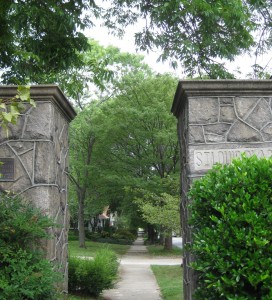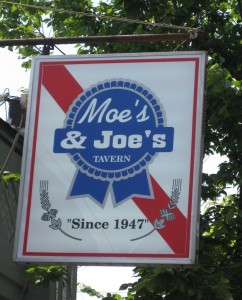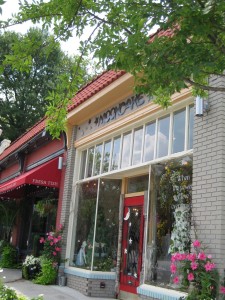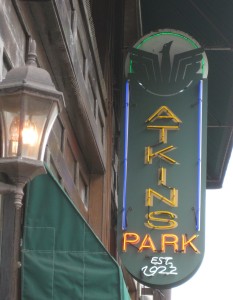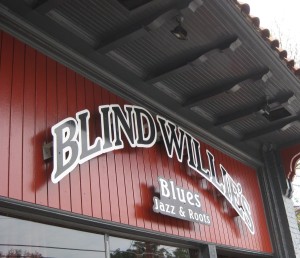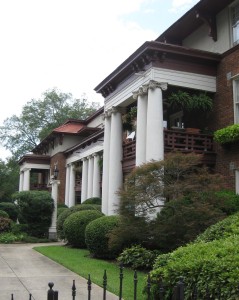St. Louis Place, a typical street in Virginia-Higland
Virginia-Highland took a bit longer than Morningside to get back on its feet after our neighborhoods succeeded in stopping the superhighway. A substantial section of Virginia Avenue had been decimated to make way for a highway interchange. The destruction had taken its toll on the surrounding homes that survived, many just barely.
In my early teen years, Virginia-Highland was old-school, no-frills and decidedly untrendy. When we filmed a Super-8 movie for a school project, the neighborhood stood in for a sleepy fictitious Kansas town, quaint but down on its luck. There were vintage barbershops and gas stations, untouched since the 40s, family-owned grocery, drug and hardware stores, and the city’s oldest operational fire station, built in 1925 in the bungalow style like many of the homes around it. Some of the proprietors wore overalls and spoke with accents now associated only with deepest South Georgia. The two burger and beer taverns, Moe’s and Joe’s and George’s, which opened respectively in 1947 and 1961, were not yet hip. (My father appreciated both places when he first arrived in town and rented a room on Ponce de Leon. Mama and I spent that summer with my grandparents in Kentucky while Daddy looked for more permanent digs). I didn’t enter either bar until I was in college, but the predominantly elderly good old boys inside could be seen in the neon gleam of the Pabst Blue Ribbon signs.
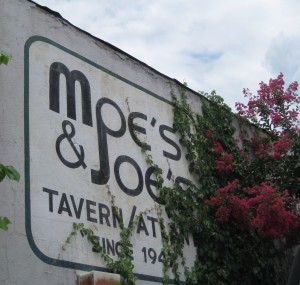
The revitalization of Virginia-Highland (according to my, perhaps flawed recollection), began with the opening of Taco Mac at the intersection of Virginia and Highland in 1979. It started as a cheap spot for beer and Buffalo wings. In its first incarnation, its décor recalled a fraternity house rec room, all plywood and bad lighting. But for the first time in years, a younger crowd began pouring into the area. College kids from Emory and Georgia Tech found Taco Mac and then discovered the dingy ironic charm of Moe’s & Joe’s and George’s. On weekend nights the crowds in Virginia-Highland rivaled those along Peachtree in Buckhead.
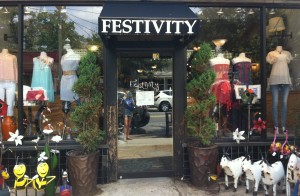
These days, the area is healthier and busier than ever, at all hours. The cost of gentrification, of course, was the loss of many of the old mom-and pop stores that had served the area during the decades when it limped along. Still, the neighborhood remains a mix of the affordable and the aspirational. Highland Hardware, which began as a hardware store with a great woodworking section, evolved into Highland Woodworking, a specialized mecca for expert woodworkers. Jimmy Carter has been a regular patron of both. Now, if you’re not an expert of any kind, and you simply need a hammer, the nearby Intown Ace Hardware will happily sell you one.
In the clothing, accessory and home goods stores, my daughter and I enjoy browsing the interesting array of items, and occasionally she finds a great little something she can afford with her own money. But we are not really big shoppers, and when we do shop, we like bargains. Virginia-Highland isn’t the place for bargains. It’s not the actual merchandise that draws us. What we particularly appreciate in these boutiques is their fanciful atmosphere and their imaginative decoration of unique old architectural spaces. Owners tend to be fun, funky and welcoming, to humans and their dogs. There’s usually a furry friend snoozing peacefully beneath a sales table or behind the counter. It’s good to know Kiko would be welcome, should we ever get him to Atlanta.
D and I were sad to see that Mooncake had closed when we returned this year. An especially charming shop, it was mentioned in one of D’s favorite books, Peace, Love and Baby Ducks, by the Atlanta author Lauren Myracle. Mama bought me a pair of my favorite earrings here, silver disks resembling manhole covers, stamped NYC Sewer.
Virginia-Highland is known for its wide variety of restaurant choices. Atkins Park (which dates from 1922 and is Atlanta’s oldest operating tavern) caters to a diverse crowd by managing to be simultaneously up-and downscale. A boisterous crowd enjoys the front bar area, while elegant comfort food is served in a quieter, classic restaurant setting in the back. Highland Tap, a fixture since the 80s, follows suit. Depending upon the mood of the patrons and the hour of the evening, the subterranean space may feel like a loud college bar or an urbane steak eatery. At Blind Willie’s, it’s possible to get basic food and listen to world-class blues and folk music. And for traditionalists and hipsters alike, Moe’s & Joe’s and George’s remain vital. These two spots have changed very little in appearance, other than the addition of flat-screen TVs (and a much younger wait-staff). My parents join my daughter and me for lunch at George’s each year after our boutique walk. I find it reassuring that there are some things in my fast-moving hometown that don’t change, at least for a few decades.
Invitingly restored apartments on North Highland.

